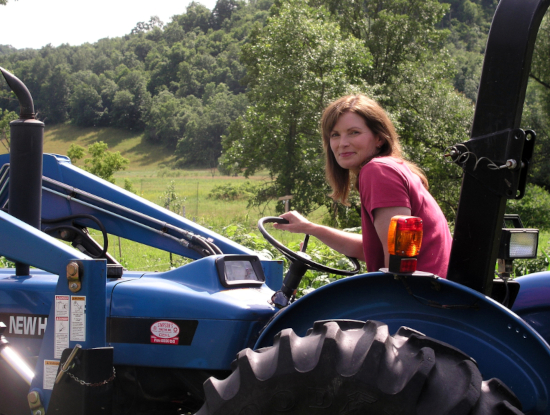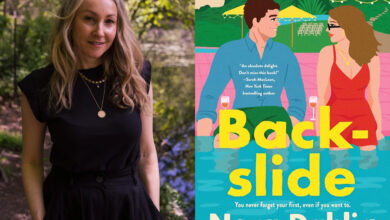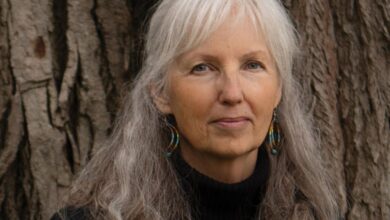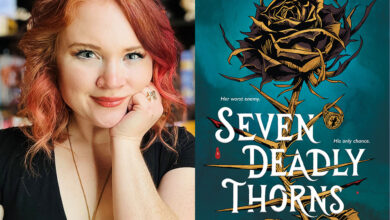A Conversation About Simple Living With Tamara Dean – Minnesota Women’s Press

A Q&A with Tamara Dean, author of Shelter and Storm: At Home in the Driftless, about her experiences while living in the Driftless region of Wisconsin.
Tell us how this book came about.
I was primarily a fiction writer when we moved out to the Driftless area. But I also wrote technical books for a living. And once I went out to the Driftless area, it seemed like every time I stepped outside the front door, something else amazing, astonishing, or weird would happen. And I thought “This is more dramatic than any fictional plot line I’m coming up with,” so I turned to writing essays about those things that happened.
But you can still see the vestiges of my fiction writing in the essays, because I like to grab the reader with some mystery or question in the beginning, and then pull readers along, as I’m discovering clues about the answers to those questions or mysteries. Along the way, I like to integrate natural science and history, and then hopefully, the reader ends up in a different place by the end of the essay than what they might have expected.
The essays are in roughly chronological in terms of how things occurred during our 15 years in the Driftless area, but not chronological in terms of when they were written. I thought about organizing them by earth, air, water, fire, elements, because they do cover those. And then I thought that was too contrived. But I didn’t want to put two essays about floods or water adjacent to each other, so I mixed them up a bit.
The first and last essays act as a natural frame for our experience. The first essay, “So Near the Soil,” sets out our intentions and how I was naive, and I learned that we wouldn’t be able to accomplish all that we were striving to do. The last essay, “Slow Blues,” describes the reasons we would eventually leave. When I wrote that essay, I didn’t know that we were going to leave. So it is a bit ambiguous by the end of the book.
I wrote an essay about building that straw bale building that I refer to in the book in other essays, but it never added up to more than the sum of its parts. It didn’t have a strong argument, which is one thing that I think essays need, because they need to be playing with an idea. I also wrote an essay about starting the radio station in Viroqua, WDRT, which David and I did, and that too, didn’t seem to add up to more than the sum of its parts. I couldn’t get a reverberating meaning out of it. So I tossed those aside.
What are factors that motivate and inform your writing the most?
I am a strong believer not only in emphasizing the sensory details to make something come alive, but also structuring things with a plot, so that it has movement. I’m not a fan of nature writing that’s very passive and contemplative, and sort of going into the woods looking for transcendence.
There’s a phrase from UK environmental writer Kathleen Jamie, who refers to some of the foundational environmental literature of the 20th century, written by men — the ‘lone enraptured male.’ When they wrote about their experiences in the wild, they eliminated their wives or partners who were with them the whole time, and erased other people from their narratives so that they could be “that independent guy waiting for transcendence, or inviting nature to give them that experience.”
I feel very strongly about including the other people around me and creating a community of people who are adding to the collective wisdom about a place and from whom I’m learning — whether that’s my neighbor, farmers, blood survivors, and Native Americans who still held collective wisdom about the area. Scientists are included in the book, as I learn about different species — such as the slow blue fireflies or the native freshwater mussels.
I also believe in transformative revision, which requires writers to continually be more honest with themselves and with the work, and to embrace greater complexity, so it ends up being more precise and more fascinating. Shortcuts are fine for a first draft. But if you dedicate yourself to transformative revision, which is opening up — wholesale cutting or rewriting or additions, as opposed to that tinkering kind of revision, which is really just editing and moving sentences around or changing a few words here and there — we not only become more honest, and embrace greater complexity in our work, but we become better people. That’s the power of writing.

Tamara Dean
I was struck by how you portrayed your neighbors in the Driftless. What, for you, is the key to making these people so vibrant?
Our neighbor to the north had this very pleasant voice — it was like the stream that we both lived on. Another woman always wore a flowered applique shirt. It might be somebody’s gate, or the things they were most interested in, or their mannerisms and speech. I wanted to show people in the best possible light, while also incorporating their difficult or challenging moments too. I hope that I was fair with all the neighbors I portrayed.
In such a rural area, emergency services might not be quick to respond, and they might not respond in the same way as relying on neighbors would be. So when we had a fire get out of control, during our prairie restoration — a prescribed burn— it was in an area where the fire department would not have gone, because you had to drive through a river to get across the field and then up the hill. There was no possibility of emergency services helping. So the fact that our neighbors dropped everything and said, “We had other plans, but this is what we’re planning to do now,” and came and helped us fight the fire was extraordinary. But it was also par for the course in our rural area.
We helped others after floods, emptying their basements or whatever they needed. Even if your politics weren’t the same. The people who filled our rainwater cistern, which mysteriously emptied while we were on vacation — who got a truck filled up at the fire station and poured all that water into our cistern — never asked about our politics. I bet they knew that it might not conform to their own beliefs, but that never came up.
What was one aspect of sustainable farming and living off the land that was not expected?
David and I knew we were naive when we set out to experiment with sustainable living, but we had no idea how naive we were. In particular, we didn’t understand how extreme weather would dictate anything we did, and put the kibosh on our plans. The weather thoroughly controlled our day-to-day activities. The extreme weather happened a lot more frequently, with greater drama than we expected. During the time we lived there, we had seven record-breaking floods in the span of 11 years. One was in August 2018, called “the 1000 year flood” by some old locals. They had never seen anything like it, and that’s the truth for that area of Wisconsin.
The Wisconsin Initiative on Climate Change Impacts has predicted heavier and more frequent rain events as climate change continues for that area. So, the extreme weather was a shock to us. In the city, you can get away with ignoring weather for the most part. It’s not going to dictate if you’re able to do something on your list for the day.
What do you anticipate will happen to the Driftless region with climate changes effects worsening?
I have to believe that those floods are going to continue. After the 1000 year flood in 2018, they decided not to replace the dams that were destroyed in the flood. That changes the dynamics of the waterways and the whole system. So it’ll be interesting to see how the floods are the next time around. Two of the villages have moved to higher ground, Gays Mills and Soldiers Grove, [as] those areas were so dramatically impacted. Soldiers Grove moved after the 1978 flood, and then Gays Mills moved after the 2008 flood.
What kind of preventative action can those communities take against these types of environmental disasters that are increasing because of climate change?
The “Floodways” essay in Shelter and Storm describes an oral history project that my friends from the Driftless Writing Center and I embarked on. We captured the stories of survivors, and demonstrated how storytelling can help people heal from traumatic experiences. We shared excerpts with policy makers and public planners throughout the area, and those insights are still making an impact. As recently as a couple months ago, I heard about that wisdom being shared at planning meetings, and it comes up in watershed councils or municipal planning meetings.
It’s a demonstration of the arts and community and politics coming together to make a better place for everyone.
Coon Creek Watershed Council has helped land owners understand and implement erosion prevention techniques along the waterways, such as buffer zones. The more of that you can have, as opposed to plowing right up to the river bank, the better off the waterways. They’ll be more resilient for the next flood, and the water quality will be better as well.
So there are measures being taken around the Driftless area, but I don’t know about any other communities moving to higher ground. That is a big undertaking. It requires not only buy-in from the community, but also a significant investment, and probably either state or federal funds to help out.
What is one aspect of the Driftless that you miss?
I miss the beauty of the landscape. We fell in love with the landscape, as a lot of people do when they visit there. We knew instantly that’s where we wanted to start over when we went looking for land in 2004. So I miss that beauty, just the availability of it and the constancy of the beauty around us. I could step out my door and something amazing would happen: watching raccoons swing like monkeys through the top of an oak tree and just scarf down acorns all morning. Where else would I see that?
Or discovering a snake in an overhand knot in the middle of a deer path in the woods. I learned so much about nature, being so close to it there. I miss that the most, but I also miss the community. So many friends we had. I do go back occasionally. One of the best things is walking into a cafe or the food co-op in Viroqua, and bumping into people I haven’t seen in years, and just picking up the conversation where we left off.
We have driven by the house, but it’s a little heartbreaking to see that the new owners aren’t maintaining it in the same way that we would. I think they aren’t there all the time, so it’s a little rougher around the edges than when we lived there.
What is one thing that people reading this can do as a kind of call to action if they want to implement sustainability practices in their own lives?
Not everyone needs to go back to the land to engage with nature and community. I recommend people nurture their curiosity about the natural world, find an aspect of it that they’re passionate about, and get engaged with that — whether that’s putting seeds in the ground in a community garden or planting a pocket prairie of native grasses in their front yard or even just on the back deck.
Pollinators are in real trouble, so everything we can do to provide them with sustenance is helpful. Or maybe it’s becoming a citizen scientist. The Department of Natural Resources, at least in Wisconsin, doesn’t have the staffing or funding to cover all that they need to in terms of tracking species, where they’re thriving, and where they’re having difficulty. So citizen scientists fill that gap, because they can go out to a prairie or a waterway and look for species and then record them, for example, on online databases such as inaturalist.org.
I was a citizen scientist testing waterways on the river behind our house, and then I learned all about freshwater native mussels. People become passionate about mussels after learning how they’ve been impaired by all the environmental threats — from manufacturing to damming to climate change to run off from farms and factories and cities. They’re so important to our ecosystem. They filter gallons of water per day, and they’re fascinating in their life cycle.
There’s also research that shows that when people are part of a grassroots, hands-on effort to counteract environmental threats, they’re more optimistic than if they were looking at the giant picture of climate change, and thinking “How the heck can we do anything about it?” I think it’s important to kindle that optimism and find joy in our pursuits, with respect to engaging with the natural world.
So in short, find your passion. Join a small group, if that works for you and don’t give up. As writer Jenny Odell says, “It is in the nature of nature to try to flourish, Giving up on life is unnatural.”
Anything else you want to add?
This area of Wisconsin, the Driftless area, was never touched by glaciers. Glaciers leave behind this drift of rocks and sand, and that area has never been glaciated. It has been a refuge for millennia for all kinds of plant and animal species. Ho-Chunk oral history talks about their ancestors being pushed southwest from what’s currently the Green Bay area to the Driftless as the most recent glacier advanced. There are some endangered and threatened species that find a home there.
Because of the Driftless nature it wasn’t flattened like the rest of the Midwest, so it wasn’t subject to all the thousands of acres of corn or soy. It’s more suitable for small family farms or experimental, regenerative, or organic farming, and that’s affected the culture. I think it’s an interesting example of how topography affects culture.
Excerpt from Shelter and Storm: At Home in the Driftless, by Tamara Dean (University of Minnesota Press, 2025)
When David and I conceived of building our own house of mud bricks, we shared [Woody] Guthrie’s distrust of government and a desire to live on our own terms. We were reading books on peak oil, climate change, alternative building, and renewable energy. We had earnest, romantic notions of sustainable something, responsible something, homemade or homegrown something. Like Guthrie’s protagonists, we lusted for a home made by us and for us and sought stability in the face of uncertain economic and environmental climates. Accompanying our intentions was a what-the-hell spirit. We wanted to undertake something extraordinary together. We recognized our naivete (the fact of it, if not its depth), but we were determined — stiff-necked and disinclined to bow down.
Source link





